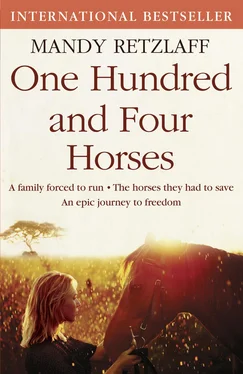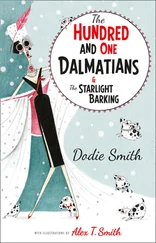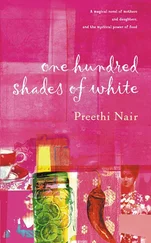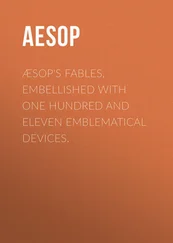SOON AFTER WE came to Crofton, we drove over to the neighboring Two Tree Hill Farm to see trucks being unloaded at the farmhouse on top of the hill. The new neighbors, it seemed, had finally arrived. Our lives—and the lives of our horses—were about to become richer than ever, as we welcomed long-lasting, genuine friends into our world.
We had heard that new managers were moving into Two Tree from the farm’s owner, a middle-aged South African named Les De Jager. During the bush war, Les had fought with a unit of the SAP, the South African Police, who were supporting the Rhodesian army. On patrol deep in virgin bush, he and his unit had set up camp along the banks of a river. That night, Les had an epiphany: this was the perfect site to build a dam wall, opening the river for the irrigation of all the untamed land that stretched around. When he closed his eyes, he could see it: the bush driven back, the land opened up with tobacco, soybeans, wheat, and more. It was an image so vivid that, when the bush war came to its conclusion, Les left his native South Africa and came here to see the dream fulfilled. Two Tree Hill now stood, testament to the nocturnal visions of a soldier too long away from home.
As we reached Two Tree, we saw a slim man, perhaps the same age as Pat, rolling up his sleeves and stepping into the back of one of his trucks. He had the most wonderful smile, vivid blue eyes, and curly blond hair. He stepped into the darkness of the truck. He was out of sight for only a few moments before he reemerged, leading behind him a beautiful bay mare.
It was while he was turning to lead a second horse out of the box that he first saw us.
“You must be Pat and Mandy,” he began. “My name’s Charl. Charl Geldenhuys.” He took a step back, his eye line almost level with Kate’s. “And this must be …”
“Her name’s Frisky,” Pat cut in.
Charl stepped back, admiring the old mare that Pat and Kate were riding. Then, he turned, ambling back to the horse he had already offloaded.
“This is Lady Richmond,” he said, laying his hands on her flank.
Charl, it transpired, had been the manager on Two Tree some years before. He had spent five years managing the farm before meeting and falling in love with the woman who was to be his wife, Tertia. They had been married in South Africa and spent two blissful years there, Tertia giving birth to a wonderful daughter, Resje, who was only a little younger than Kate. Charl had talked so nostalgically about his time on Two Tree that he had convinced Tertia to visit it as a holiday—and it was then that Tertia, a city girl at heart, had fallen in love with the wild, open spaces of Two Tree Hill. The farm, she saw, was a paradise, its wild places teeming with reedbuck, tsessebe, kudu, and sable. Charl could do nothing other than petition Les De Jager for his old job.
When Charl introduced us, I liked Tertia immediately: small, with dark hair, and the most expressive brown eyes I had ever seen. Resje clung to her as she introduced herself. She had the same warm brown eyes as her mother and, we were to learn, had been born with a birthmark that covered almost all of her body. As a result, the brave little girl had to spend many months in hospitals across the course of her young life, and Tertia was the most devoted and caring mother.
Having managed Two Tree once before, Charl was familiar with its every hill and outcrop of bush, the bream in the dam, and the contours of the land. Tertia seemed to take to the country life with brave aplomb, playing the role of the perfect hostess. We began to spend many weekends with the Geldenhuyses at Two Tree farmhouse. Tertia would host lunches or preside over a braai (barbecue), and while we swapped stories long into the night, Pat and Charl would talk about the land, the game—and, most of all, their horses.
Charl was as avid a horseman as Pat, and countless were the days that were lost as they rode together, from one end of Two Tree to the farthest side of Crofton, taking in the sweeping bush and fields full of crops. As Frisky was to Pat, so was Lady Richmond to Charl—and when she came into foal, there could not have been a cause for a greater celebration on Two Tree.
Lady Richmond gave birth to a chestnut filly with a flaxen mane and a stately, self-assured look about her. The foal was so striking that Charl decided to name her Lady, after her mother. But in the first few hours after Lady was born, Charl knew that something was wrong. He had been around horses all his life, and instinct told him that this was bad. That night, Pat arrived at Two Tree to see for himself. In her paddock, Lady Richmond lay, weak and exhausted, seemingly not having recovered from giving birth. There was very little to say, for both men understood what had happened. In giving birth, Lady Richmond had torn herself inside; her foal, Lady, was strong and healthy, but Lady Richmond herself was rapidly fading away.
Come the morning, Lady Richmond’s eyes were closed, her breathing shallow and ragged. Come the evening, she was gone, leaving behind her day-old foal.
Lady Richmond was buried on Two Tree, but her foal needed Charl and Tertia now. They would have to act as surrogates to the orphaned horse. Now, when Pat and I took the children to visit Two Tree farmhouse on a weekend, we would find Tertia and Resje sitting on the lawn with the dainty little foal greedily sucking on her bottle. Once she was full, Lady would race around the lawn, cutting circles around her adoptive family, kicking out with her hooves.
Watching the tiny creature hurtle around the garden, seeing how Resje delighted in watching her tumble, I knew that our new neighbors were the very best kind of people: the kind who would reach out to a creature in need and step up to whatever challenge life threw at them. Without Charl and Tertia, Lady would have perished at her mother’s side. Now, watching as Kate was allowed to hold out a bottle and let Lady suckle from its tip, I was reminded more than ever of the trust that our horses, and indeed all our animals, put in us. It was a thought that would come back to me time and again over the following years as, too often to mention, I would look into a helpless horse’s eyes and, though I knew we did not truly have the means to help, promise them we would never let them go.
As the months and years passed, Pat and Charl sat up long into the nights, reminiscing and dreaming of the things they could do with this land. I had always known that my husband was a very specific kind of dreamer: the kind of man who could concoct an elaborate, wild scheme and actually see it to fruition. He had been that type ever since he was a boy, building great chicken empires or collecting his own herds of cattle, and I began to see now how our new life on Crofton was the natural conclusion. He and Charl would ride the boundaries and talk about which corners of bush might be conquered next. They would dream of new dams and roads, irrigation schemes so ambitious they might bring greenery to deserts. But most of all, they dreamed about their horses, and how they might breed something very special into their herds.
The opportunity for something a little special came soon after Lady was orphaned. When a fellow farmer was looking to transport one of his Arabian stallions to its new owners in Zambia, Charl agreed to provide a temporary home for the stallion on its journey north. This, Pat and Charl both agreed, was an opportunity too perfect to miss, a chance to add something of the Arabian’s natural versatility into the bloodline on Two Tree. Arabian horses are one of the most recognizable of all horse breeds and date back almost five millennia, to when they were first bred by the Bedouin people on the Arabian peninsula. Selectively bred for the strength of the bond they develop with their riders, as well as their high spirits and endurance, Arabians have a distinctive head shape and high tail carriage—and the thought of letting this opportunity pass by was more than any avid horseman could bear.
Читать дальше












